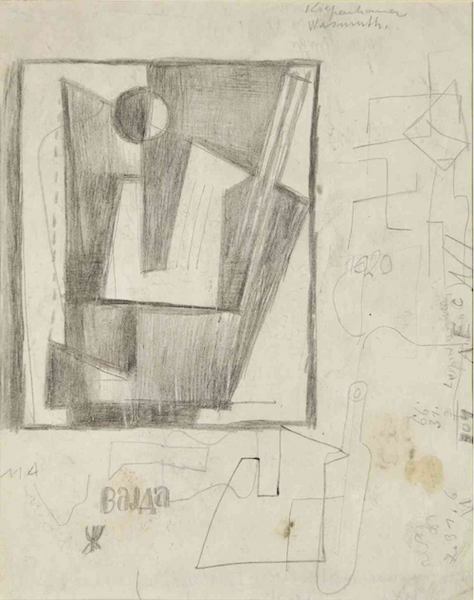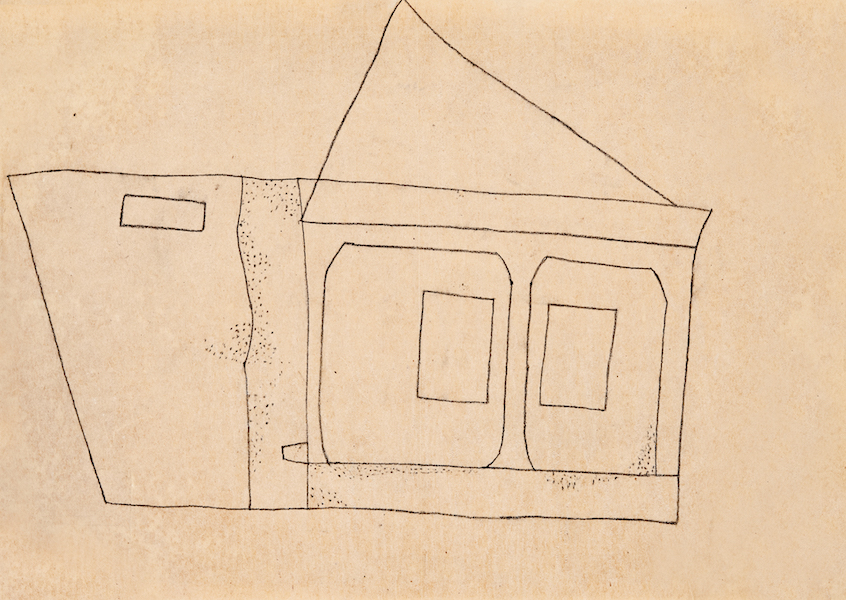Biography
In 1915, the Vajda family moved to Serbia; They lived in Belgrade and Valjevo. In 1922, they moved back to Hungary, where they lived sometimes in Zalaegerszeg, sometimes in Budapest. In 1923, they permanently settled in Szentendre. It was then that Vajda started drawing regularly at the OMIKE drawing school, where his teacher was Lipót Herman, among others. Between 1928-30 he studied at the Academy of Fine Arts under István Csók. In 1928, he joined Kassák's Munka-Circle, and in that year, as well as in 1930, he participated in the group exhibition of New Progressive Artists (Nemzeti Szalon, Tamás Gallery).
Between 1930 and 1934 he lived in Paris, where he studied the materials of the Musée de l'Homme and the Musée Guimet and became familiar with the modern art of the time. He was greatly influenced by the works of the old sacred cultures, as well as the Romanesque and Gothic cathedrals of France. Here he developed a friendship with Lajos Szabó, whom he had already met from the Munka-Circle. His circle of friends also included sculptor István Hajdu and painter Sándor Trauner, later set designer. At that time, he saw the intersection of the artistic problematics of his time in the program of Malevich and Kandinsky, as well as in the aspirations of modern Russian and French cinematography. His photomontages made here show the direct influence of time and place. In 1934, after a long period of poverty, he returned to Hungary physically exhausted, but artistically recharged and prepared.
From then on, he worked at Szentendre. In 1935, he met his future wife, Júlia Richter (Vajda). In 1935-36, he carried out ethnological collection work with Dezső Korniss in Szentendre, Szigetmonostor and other surrounding villages. They collected the motifs of objects, buildings and ornamental decorations in popular use at the same time. Its goal was to express Hungary's special situation, wedged between East and West. At that time, his figurative art was influenced by the Orthodox icons already known from his childhood Serbian memories. In 1937, he had an independent exhibition in the studio of Imre Ámos in Budapest; In 1939, his solo exhibition opened in Gusztáv Seiden's studio. In the fall of 1940, he was on labor duty for six weeks, and was hospitalized in December. He died in September 1941 in Budapest, of lung trouble.
From the time of his relationship with the Munka-Circle, from the end of the 1920s, his constructivist compositions, primarily related to the spirit of El Liszicki, reminiscent of cover designs, are known (Film; Fics, 1928). From the point of view of the further development of his art, his cubistic, structured still lifes of this time are also of decisive importance (Constructivist still life, 1928; Still life with candles and flower jug, 1928). This type of construction from geometrical forms can also be observed in some compositions made in the mid-1930s (Window at Szigetmonostor c. 1935; Gate, 1935).
In Paris, learning about the aspirations of contemporary fine art, he came to the conclusion that the isms had exhausted the potential of painting. He believed that the problems raised by painting would unfold in photography and film in the 20th century. His photomontages made during his years in Paris are usually characterized by the confrontation of extremes. The details cut out from various newspapers and picture magazines placed next to each other on the neutral cardboard base carry an unusual tension (War, 1930–33; Panther and Lily, 1930–33; Tolstoy és Gandhi, 1930–33).
His later collages from Szentendre, as well as his multifaceted drawing and tempera montages, also follow the editing procedure of this genre, so montage is present almost throughout his oeuvre. After returning home from Paris, he first created timeless portraits (Lowered female head, 1934), still lifes composed from an emphatic top view, creating a somewhat metaphysical effect (Still life with glasses and matches, 1934; Still life on a horseshoe-shaped table, 1934).
In 1935, during the collection of motifs carried out together with Korniss in and around Szentendre, they assessed the image of the small town summarizing the various influences (Baroque, Serbian Orthodox, Swabian, Hungarian folk). Vajda immortalized the motifs he considered important in line drawings (House wall at Szigetmonostor, 1935), which appeared in his paintings even in a foreign environment (House in Szigetmonostor, 1935). According to the common conviction of the two painters, truly modern art can only be created on the basis of organic traditions. In addition to tempera and oil painting, his favorite genre at this time was collage (Tower, 1935), and within his pencil drawings he often used montage-like editing (Self-portrait with a church tower, 1935). He defined this method of synthesis as "constructive-surrealist thematics". With the help of this, he and Korniss outlined the so-called program in Szentendre. The essence of this is that with the help of going back to traditions (peasant architecture and object culture, or in the case of ~, Byzantine-Orthodox art) and the formal language-perspective methods of the avant-garde, a specific, new, Central-Eastern European art can be created. This tradition- and synthesis-creating program reflected on the basic issues of modern Hungarian art (i.e. the lack of tradition and synthesis), and at the same time placed Hungarian art in an international context.
Another problem that preoccupies Vajda is the representation of the human figure (Three Brothers, 1936; Two Sisters, 1936) and face using the basic geometric structure offered by icons (Self-Portrait with Lilys, 1936; Icon Self-Portrait, 1936).
In 1937, a multidirectional change began in his art. While between 1935 and 1937 the same motifs in his works (elements of his motif dictionary consisting of 15 to 20 elements) found their way into a new environment, often through copying, his paintings in 1937 underwent a thematic change. Some of the new motifs, such as the lamp or the lamb (from an embroidered tablecloth), fit relatively seamlessly into the range of pictorial elements from 1935–36. In addition to the symbolic motifs born in the spirit of universality, however, pictorial elements with a personal motive and carrying a stronger emotional charge than before appeared more and more often (Houses in Szentendre with crucifix, 1937). Another significant difference is that the balance between constructivism and surrealism was disrupted, and surrealist elements dominated his works. It is also a new phenomenon that the previously microcosmic image editing was replaced by fragmentation, and the hierarchical relationships between the elements became more pronounced. These changes can be observed in his charcoal and chalk drawings (Lamb with oil lamp, 1937), his collages (Collage of Birds, 1937) and his paintings (Architectural motifs with small torso, 1937). From that time on, the crystal clear, sometimes intersecting faces gradually turned into grimacing, suffering figures and masks. It is as if these images were colored versions of the popular processes of surrealist photography, the superimposed, shifted portraits, where the pastel colors soften the terror they create (Monster Head, 1938; Brown Mesh Mask, 1938).
The works of his last period are outside the conventions of Western and Eastern art as much as they are outside of history, time and specific locations. (Ancient Mountain, 1939). His pictorial elements are copies of gummy tree barks, petroglyphs, signs carved in stone or drawn in sand, even an identifiable motif (fish, bird, hair braid) appears on them. At the same time, it is precisely because of their unidentifiability that they evoke the association of cold, painful alienation (Charcoal drawing on a black background, 1939; Waterside World, 1939). Even the landscape is lost in his last series of charcoal drawings. Shattered, fibrous webs swirl in the vacuum. Within the forms, the lines of expressive power are dynamically swirling, leading to the "deep world of the soul" (Ernő Kállai) (Primitive Vegetation; Drift; Root World; Solid forms with little white, 1940).


